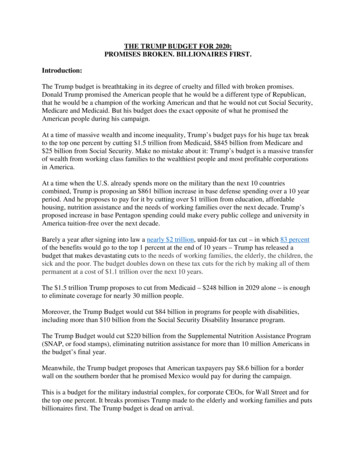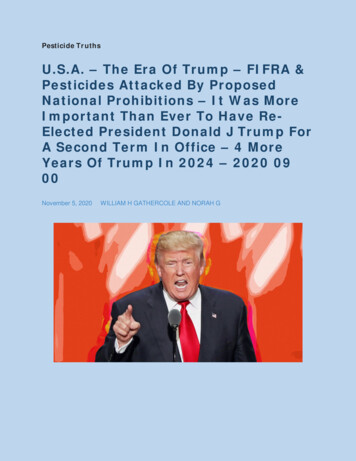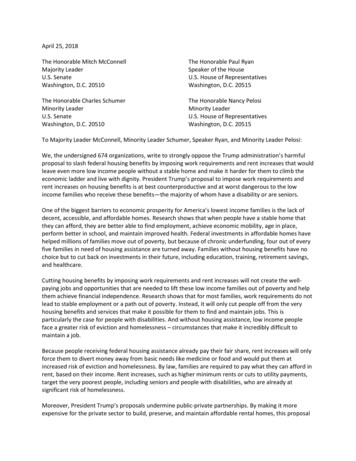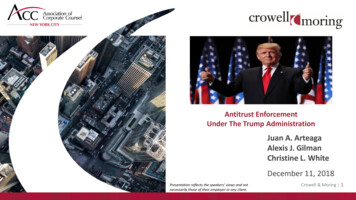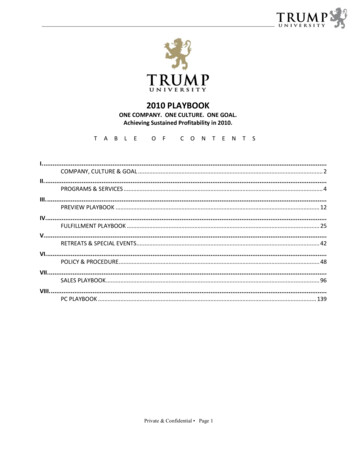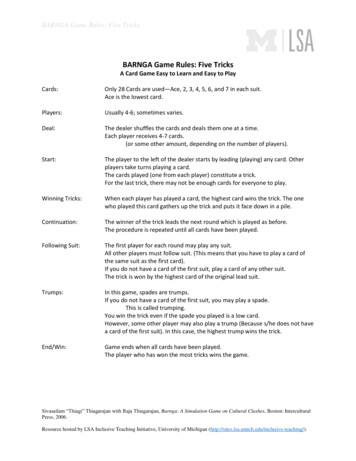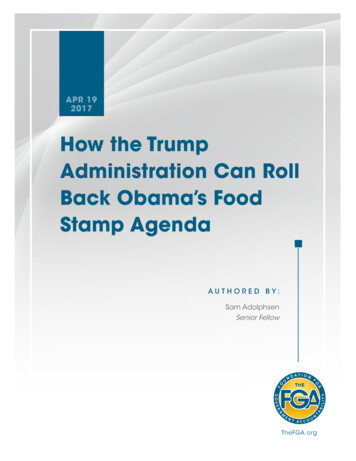
Transcription
APR 192017How the TrumpAdministration Can RollBack Obama’s FoodStamp AgendaAUTHORED BY:Sam AdolphsenSenior FellowTheFGA.org
There are more people on food stamps in the U.S. than the total population ofCanada.Over the last eight years, the Obama administration implemented policies that grewthe food stamp rolls, discouraged work in welfare programs, and held states backfrom freeing people from government dependency.To restore work and bring integrity back to this taxpayer-funded program, the Trumpadministration can start rolling back the Obama food stamp agenda by making 10simple changes to regulations and policies.Restore Work1. Empower states to expand work requirementsThe current work registration requirements for non-disabled parents on food stamps is insufficientto move adults from dependence to self-sufficiency, as evidenced by the fact that half ofall able-bodied parents on food stamps have no earned income. Non-disabled, workingage adults over the age of 50 are also exempt from mandatory work requirements. These twopopulations – non-disabled parents and non-disabled adults between 50 and 64 years old –should be required to work to receive food stamps.AC T I O N S T E P S Allow requesting states to expand the existing work rules for childless adults to nondisabled parents on food stamps and expand the age range beyond its current capof 50 years old. This can be done by granting state waiver request for a demonstrationproject that is aimed at increasing the self-sufficiency of SNAP recipients.1 These demonstrations should also include tracking and evaluation componentsto test whether these policies improved work levels and earned incomes for theindividuals covered under the demonstration.2. Deny state work requirement waiversFood stamp law is clear that any waiver to the able-bodied adults without dependents (ABAWD)work requirement must include one of two criteria: an “area” must have 1. A 10 percent orhigher unemployment rate or 2. A demonstrated lack of job opportunities.2 But over time,regulators have expanded this law dramatically in several ways: Granting waivers based on unemployment measures Congress did not set (20percent higher than national average) Granting waivers because there is a “lack of job opportunities” according to adescription “in an academic study or other publication”3TheFGA.org Allowing partial waivers for any “area” the state defines (typically county based)2How the Trump Administration Can Roll Back Obama’s Food Stamp Agenda
This application of the law is far too broad. For example, California, which has been granteda statewide waiver for work requirements as of the third quarter of Fiscal Year 20174, has afive percent statewide unemployment rate, nearing its all-time low.5 Rhode Island also has astatewide waiver from work requirements, despite its 4.5% unemployment rate. Based on theplain reading of federal law, California and Rhode Island should not be eligible for a statewidewaiver of work requirements.Further, allowing states to have partial waivers by county ignores the reality that neighboringcounties may be economically vibrant. For example, California’s Sutter County, which hasan unemployment rate of 11.1 percent, is bordered by five counties that have lower than 10percent unemployment.Partial waivers also make state administration more difficult.FNS should not grant waivers based on a state having “a 24-month average unemploymentrate 20 percent above the national average for the same 24-month period.” This basicallyguarantees that some states will always be eligible to waive the requirement for work, even iftheir unemployment is low but relatively higher than other states. For example, if California’sunemployment rate drops all the way to two percent but the national average is 1.6 percent,California could still qualify for a work requirement waiver under the current policy.These examples are all clearly outside the bounds of the narrow exceptions Congress outlined.AC T I O N S T E P S FNS should not grant further ABAWD work requirement waivers, including partialwaivers. No state currently has an unemployment rate above seven percent andthere are currently 5.7 million job openings across the country.6TheFGA.org Change regulations in 273.24(f)(2)(ii) to eliminate the “20 percent above the nationalaverage” and the vague “not enough jobs” criteria.3How the Trump Administration Can Roll Back Obama’s Food Stamp Agenda
3. Enforce all existing work requirements in SNAPIn addition to the work requirements for ABAWDs, there are requirements for other able-bodiedadults in SNAP. These requirements, outlined in 7 U.S. Code § 2015 (d)(1), include all “physicallyand mentally fit” or able-bodied adults between the ages of 16 and 60 including parents.7This requirement is less stringent than ABAWD requirements, but requires that these individuals“register” for employment, not turn down a job, not quit a job, participate in programs asrequired, and generally cooperate. Unfortunately, there are states that are not enforcing thisimportant provision.AC T I O N S T E P S Review state compliance with the work requirement for this population as outlinedin federal law, examining reports from each state detailing for the full prior calendaryear: How many households and individuals are enrolled in this category How many exemptions have been granted How many individuals have registered for work How many individuals have voluntarily quit a job How many individuals have refused employment training How many individuals have elected not to take an offered job How many individuals have been sanctioned for a failure to comply in the previousyear States that are not properly removing enrollees for failure to work should be requiredto submit corrective actions to explain how they will comply with this provision.4. Require 50-year-old able-bodied adults without dependents to workFederal rules currently exempt 50-year-old able-bodied adults without dependents on foodstamps from work requirements, despite statutory language indicating that they should besubject to those requirements. The Office of the Inspector General notes that the current rulesuse two different, contradictory interpretations of the statutory language to limit the number ofindividuals impacted by the work requirement.8The OIG stated in their September 2016 report that FNS’s conflicting interpretations “do notseem reasonable to us.” The administration should take the recommendation of the OIG and expand thework requirement to 50-year-old able-bodied adults, compliant with federal law.TheFGA.orgAC T I O N S T E P4How the Trump Administration Can Roll Back Obama’s Food Stamp Agenda
5. Eliminate carry-over exemptions from work requirementsFederal rules allow states to carry over unused exemptions from the work requirement for ablebodied adults without dependents on food stamps. These exemptions can be used broadlyto exempt any ABAWD from work, up to 15 percent of the total ABAWD population. FNS hasbeen using this exemption in a way that goes beyond the scope of federal law and fostersdependency.The OIG has raised concerns about this practice, noting in their September 2016 report that they“do not agree with FNS’ process of carrying over unused 15 percent exemptions indefinitely.”9 Todate, states have carried over approximately 1 billion worth of work requirement exemptions.AC T I O N S T E P The administration should follow the advice of the OIG and eliminate carry-overexemptions. As the OIG outlines and FNS acknowledges, this is simply a “long-standinginterpretation.” This should be interpreted correctly immediately by eliminating thecarry over.Rein in Insider Expansions6. End gimmicks that give food stamps to people with higher incomesRecent federal regulations and policies have dramatically widened the front door to food stamps.One of the most contrived expansion methods is through “broad-based categorical eligibility”(BBCE). This addition to traditional eligibility standards allows millions of individuals to receivefood stamps when they would otherwise be ineligible based on their income and assets.BBCE qualifies an individual for food stamps if they receive a non-cash service from the TemporaryAssistance for Needy Families (TANF) program. But in reality, what individuals receive is often nota service at all and may not even be physically provided to them. For example, in some states,“being referred to a TANF service” by receiving a brochure qualifies someone for SNAP.The application of BBCE exceeds authority in the law and in the overly broad rule. For example,what confers eligibility is supposed to be a “service,” as outlined in regulation. But all states areoffering is simply a phone number, or a brochure, that was created with TANF funds, to make theperson eligible. These items should not qualify as “services” since they do nothing on their own toassist the person. Further, some states say they produce a brochure, but are not actually providingthem to the individual physically, but simply stating that the person is eligible to receive it.FNS pushed states to utilize BBCE in a 2009 memo. Specifically, they cited BBCE as a meansto increase food stamp enrollment. “We encourage you to continue promoting expandedcategorical eligibility as a way to increase SNAP participation,” the memo pleaded.10 The Trump administration should not allow states to make individuals broadlycategorically eligible for food stamps when they are not receiving an actual serviceof some kind funded by TANF, compliant with current law and rule. The Trump administration should repeal broad-based categorical eligibility.TheFGA.orgAC T I O N S T E P S5How the Trump Administration Can Roll Back Obama’s Food Stamp Agenda
7. Eliminate bonus money for increased food stamp enrollmentFederal law authorizes the distribution of 48 million in “bonus” funds annually to states thathave “high and most improved performance” in administering the food stamp program. Thelaw outlines that the performance criteria for selecting recipients of the funds will be:(I) actions taken to correct errors, reduce rates of error, and improve eligibilitydeterminations; and(II) other indicators of effective administration determined by the Secretary;11The regulations and practices of FNS have expanded these criteria to include a bonus paymentgiven for improving or having a high “program access index,” a measure created by FNS todetermine how many people are on food stamps compared to how many they believe areeligible in each state.12 The total bonus given out for this measure is 12 million annually, thesecond highest total award category.In the 2014 farm bill, Congress barred FNS and states from using funds to advertise and promotethe SNAP program to recruit more recipients. Awarding increased enrollment through bonusesin “program access” seems to approach (if not cross) this line because it rewards states whoincrease enrollment.AC T I O N S T E P S The Trump administration should provide bonus money to states only for actualprogram efficiency as the law intended, not for increased level of enrollment. Thecurrent rule should be changed to distribute the 12 million to states that are returningSNAP recipients to employment. FNS should remove “outreach” materials from their website and stop asking states todevelop “outreach” plans to recruit more people to the program.8. Release SNAP retailer data on food stamp purchasesUnder Obama FNS was not transparent with data about how food stamp dollars are beingspent. In 2011, FNS rejected a request for all retailer level food stamp spending. The requestorsued the Obama administration and, after years of litigation, won their case in late 2016. Thewin was definitive – the data is not protected under Freedom of Information Act exemptionsas the Administration’s lawyers argued.13 However, an outside group filed a motion to staythe decision in early 2017 and FNS has stated they will not release SNAP retailer data until thepending court case is resolved.14Releasing the data will also allow for better scrutiny of potential retail fraud. In Maine, this typeof information helped the state and FBI uncover a multi-million dollar SNAP and tax fraudscheme.15TheFGA.orgThe requested data is not private. It did not include any personal information. And this data isimportant because it will help the public understand how billions of taxpayer dollars are beingspent.6How the Trump Administration Can Roll Back Obama’s Food Stamp Agenda
AC T I O N S T E P S Immediately release (in Excel or .csv format) the last 8 years of retailer data that, at aminimum, includes: Retailer name Retailer address, city and state FNS ID number Total EBT/SNAP transactions for each month Release regular updates of the data, no less than monthly. Make transaction-level data available (without unique, personally-identifyinginformation) for at least the previous year.Roll Back Lame Duck Rules9. Ban significant lottery and gambling winners from food stampsThe 2014 farm bill banned lottery and gambling winners from continuing to receive food stamps.This was a prudent and critical step. Reports around the country have found individuals scoringhuge amounts of cash – even more than a million dollars – in lottery and gambling winningsyet remained on food stamps.Congress left it up to the Secretary of USDA to define the “substantial” level of lottery or gamblingwinnings at which food stamp recipients would be removed from the program.There are severalproblems with the way in which the Secretary of USDA decided to implement this provision.From the Foundation for Government Accountability’s comment on the rule:“FNS delayed defining “substantial” for nearly three years. They also explicitly told statesnot to enforce this law until “substantial” was defined. Now, FNS is attempting to define“substantial” at a threshold that is unreasonably high, does not comport with the monthlynature of the benefit, and is out of scale with other financial laws. This proposed rule wouldkeep people on the SNAP program after winning huge amounts in the lottery, in directconflict with the intent of Congress as delineated in the 2014 Farm Bill, Section 4009.”16AC T I O N S T E PTheFGA.org The Secretary should change the rule to define “substantial” winnings in lottery orgambling as winnings of 2,250 or more to align with the federal asset test in SNAP.7How the Trump Administration Can Roll Back Obama’s Food Stamp Agenda
10. Eliminate Obama’s last-minute photos-on-EBT-cards obstructionFederal law is explicitly clear that states can place photos of food stamp enrollees ontheir electronic benefits transfer (EBT) cards. In the waning days of the lame duck Obamaadministration, a rule was passed that adds significant and problematic regulatory burdenson states who choose to exercise this option.Below is the entirety of what federal law says on the topic:(9) Optional photographic identification.—(A) In general.— A State agency may require that an electronic benefit card contain aphotograph of 1 or more members of a household.(B) Other authorized users.— If a State agency requires a photograph on an electronic benefitcard under subparagraph (A), the State agency shall establish procedures to ensure thatany other appropriate member of the household or any authorized representative of thehousehold may utilize the card.The rule section on “minimum requirements” goes far beyond the federal law. As the state ofMaine laid out in their comments on the rule,“federal law grants states the option to implementphoto EBT, without tying that option to performance standards and without delegating authorityto the Secretary of the Department of Agriculture to impose that limitation or any other.”17AC T I O N S T E PTheFGA.org The Trump administration should immediately repeal the EBT-photo regulation. Therule goes beyond the scope of the narrow federal law which allows states to placephotos on EBT cards with none of the additional restrictions added by the rule.8How the Trump Administration Can Roll Back Obama’s Food Stamp Agenda
REFERENCES7 U.S.C. § 2026 (b)(B)(ii)(II)2.7 U.S.C. § 2015 (o)(4)3.7 C.F.R. § 273.24(f)(2)(ii)4.Food and Nutrition Service, “Status of state able-bodied adult without dependents (ABAWD) time limit waivers fiscal year2017 – 3rd Quarter,” U.S. Department of Agriculture (2017), FY 2017 3rdQuarter ABAWD Waiver Status.pdf.5.Bureau of Labor Statistics, “Current unemployment rates for states and historical highs/lows, seasonally adjusted,” U.S.Department of Labor (2017), https://www.bls.gov/web/laus/lauhsthl.htm.6.Bureau of Labor Statistics, “Job openings and labor turnover summary,” U.S. Department of Labor (2017), https://www.bls.gov/news.release/jolts.nr0.htm.7.7 U.S.C. § 2015 (d)(1)8.Office of Inspector General, “FNS controls over SNAP benefits for able-bodied adults without dependents,” U.S. Departmentof Agriculture (2016), .9.Office of Inspector General, “FNS controls over SNAP benefits for able-bodied adults without dependents,” U.S. Departmentof Agriculture (2016), .10.Food and Nutrition Service, “Improving access to SNAP through broad-based categorical eligibility,” U.S. Department ofAgriculture (2009), 9 0.pdf.11.7 U.S.C. § 2025 (d)12.Food and Nutrition Service, “Calculating the Supplemental Nutrition Assistance Program (SNAP) program access index: Astep-by-step guide for 2014,” U.S. Department of Agriculture (2016), /ops/PAI2014.pdf.13.Argus Leader Media v. U.S. Department of Agriculture, Memorandum opinion and order: Case no. 4:11-CV-04121-KES (Dist.S.D. 2016) Argus-Opinion-Memorandum-20161130.pdf.14.Food and Nutrition Service, “SNAP retailer data,” U.S. Department of Agriculture (2017), line Cornish, “FBI investigates alleged massive Portland welfare fraud,” WSCH-6 (2016), Sam Adolphsen, “Foundation for Government Accountability comment on FNS rule 2015-003,” Foundation for GovernmentAccountability (2017), ntId FNS-2015-0038-0028&attachmentNumber 1&contentType pdf.17.Office of Family Independence, “Comments regarding proposed rulemaking – Supplemental Nutrition Assistance Program:photo electronic benefit transfer card implementation requirements,” Maine Department of Health and Human Services(2017), ntId FNS-2016-0003-0026&attachmentNumber 1&contentType pdf.TheFGA.org1.9How the Trump Administration Can Roll Back Obama’s Food Stamp Agenda
TheFGA.org@TheFGA15275 Collier Boulevard Suite 201-279Naples, Florida 34119(239) 244-8808
Over the last eight years, the Obama administration implemented policies that grew the food stamp rolls, discouraged work in welfare programs, and held states back . To restore work and bring integrity back to this taxpayer-funded program, the Trump administration can start rolling back the Obama food stamp agenda by making 10 simple changes .



![EXHIBIT 24 [Filed Under Seal] - Washington Post](/img/32/cohen-v-trump-in-support-of-motion-for-class-certification-4.jpg)
